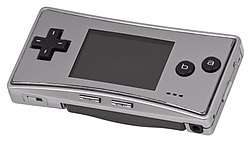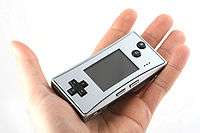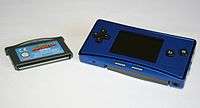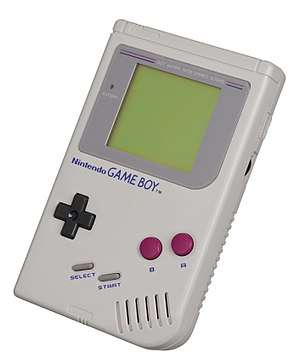Game Boy Micro
The Game Boy Micro[lower-alpha 1] (stylized as GAME BOY micro) is a handheld game console developed and manufactured by Nintendo. It was first released in September 2005 as a smaller, lighter redesign of the Game Boy Advance. The system is the last console in the Game Boy line, alongside the AGS-101 model of Game Boy Advance SP. Unlike its predecessors, the Game Boy Micro lacks backward compatibility for Game Boy and Game Boy Color games.
 | |
| Also known as | Oxy (code name)[1] |
|---|---|
| Manufacturer | Nintendo |
| Product family | Game Boy Advance family |
| Type | Handheld game console |
| Generation | Sixth generation |
| Release date | |
| Lifespan | 2005–2008 |
| Discontinued | 2008 |
| Units shipped | 2.42 million (as of March 31, 2007)[2] |
| Media | Game Boy Advance Game Pak |
| CPU | 32-bit ARM7TDMI (16.78 MHz) |
| Predecessor | Game Boy Advance SP (concurrent) |
| Successor | Nintendo DS |
History
According to Nintendo of America vice president George Harrison, the idea for a smaller version of the Game Boy was first discussed in 2004.[3] Harrison explained that unlike the traditional console development process, Nintendo was always thinking about new ideas for the Game Boy, describing it as a "continuous process of invention".[3] Developed under the code name "Oxy",[1] the company tried many ways to see how small they could make the Game Boy, opting for a metallic casing that, according to Nintendo Co. Ltd president Satoru Iwata, was "unusual for Nintendo".[4]
The Game Boy Micro was announced by Nintendo of America's vice president of sales and marketing, Reggie Fils-Aimé, at the company's Electronic Entertainment Expo press conference on May 17, 2005.[5][6] The system was released in Japan on September 13, 2005 and in North America on September 19, 2005.[7] It was released in Europe on November 4, 2005 and Australia on November 3, 2005.[8] It was released in China as the iQue Game Boy Micro on October 1, 2005, and later released in South Korea on November 9, 2005.
Design and specifications

The Game Boy Micro retains some of the functionality of the Game Boy Advance SP, but with a more compact form factor. It cannot play original Game Boy and Game Boy Color games due to design changes. Although it still has the required LR35902 processor and graphics hardware necessary to run games from older Game Boy systems, it lacks other internal hardware necessary for backward compatibility. It is incompatible with the Nintendo e-Reader and other peripherals due to similar design issues. Additionally, it has a backlit screen with the ability to adjust the brightness. The shape itself is oblong, similar to the style of the Nintendo Entertainment System controller.
The Game Boy Micro features removable, decorative housing called a faceplate. Designs with special faceplates were sold as a customization feature. Faceplates for the Micro are made using in-mould decoration.[9]
- Dimensions: 50×101×17.2 mm (2×4×0.7 in)
- Weight: 80 g (2.8 oz)
- Processor: 32-bit 16.8 MHz ARM processor (ARM7TDMI)
- Case Colors: various
- Screen: 51 mm / 2 inches, backlight with adjustable brightness.
- Resolution: 240×160 pixels
- Framerate: 60 Hz[10]
- Colors: 512 (character cell mode) or 32,768 (bitmap mode)
- Battery: built-in rechargeable lithium-ion battery, up to 5 hours of battery life with top brightness and sound or 8 hours with both features on default
- Headphones: standard 3.5mm headphone jack[11]
The Game Boy Micro has a two-way switch on its right side for adjusting volume. By holding down the L shoulder button, the switch can also be used to adjust the backlight between five levels of brightness.
Software and hardware
The Game Boy Micro is compatible with Game Boy Advance games, including Game Boy Advance Video Game Paks.
The following games/accessories are not compatible with the Game Boy Micro system:[12]:10
- Original Game Boy Game Paks
- Game Boy Color Game Paks
- Game Boy or Game Boy Advance Game Link cables
- Game Boy Advance Wireless Adapter
- Game Boy Advance e-Reader
- Nintendo GameCube Game Boy Advance cable
- Game Boy Printer
- Game Boy Camera
While Game Boy or Game Boy Advance Game Link cables and the Game Boy Advance Wireless Adapter are not compatible with the Game Boy Micro system, adapters and a Game Boy Micro-compatible Wireless adapter have been released.[12]:18 Nintendo also redesigned their Play-Yan music/video adapter to better fit the Game Boy Micro. This device is able play MP3 and digital video files from SD cards.
As with the Game Boy Advance and Game Boy Advance SP systems, there are no regional lockouts on software, so North American games can be played on Japanese or European hardware and vice versa.
Packaging
In Japan, the Game Boy Micro was released in four different base colors: black, blue, purple, and silver.[13] Also available at launch was a limited edition version, based on the controller of the Japanese version of the Nintendo Entertainment System, the Famicom.[14] In October 2005, Square Enix announced that they would be releasing a special faceplate, featuring artwork by Yoshitaka Amano, to promote their re-release of Final Fantasy IV on the Game Boy Advance.[15][16] On November 17, 2005, Nintendo released a Pokémon version in Japan, featuring a red Micro with a black faceplate containing the silhouette of Pikachu.[17][18] Another special edition of the Micro was released on April 20, 2006, which bundled Mother 3 with a red Micro and a themed faceplate.[19][20]
In the United States and Canada, the Game Boy Micro launched with two regular color choices, each sold with three interchangeable faceplates included: silver with black, "Ammonite" and "Ladybug" faceplates; and black with silver, "Flame" and "Camouflage" faceplates.[7] The "20th Anniversary" edition was released on December 4, 2005, which was the Famicom controller-inspired version released in Japan.[21][22]
In Europe the Game Boy Micro is available in four different colors, with one matching faceplate: silver, green, blue and pink. Game Boy Micro sold in Australia have the same colors (except Green which replaced by red color) as Europe.[23]
There are reportedly no plans to sell additional faceplates in the US retail locations (as indicated in the letter page in issue 200 of Nintendo Power) or the UK.[24] Nintendo of Europe cannot supply replacement faceplates of any kind, and the feature is omitted from the product's marketing, packaging, and manual in Europe. However, some third parties are manufacturing such faceplates for sale in the US and Europe, and some importers stock faceplates acquired from Japan. Nintendo of America sells some of the faceplates individually online.[25]
Unit colors
The Game Boy Micro had numerous colors and limited editions.
- Black (included silver, green camo, and fire faceplates)
- Silver (included black, flower, and blue energy faceplates)
- Green (Europe only)
- Blue (Europe and Japan only)
- Pink (Europe only)
- Red (Australia only)
- Lavender (Japan only)
- Famicom 20th Anniversary Edition
- Final Fantasy IV
- Lite Blue (Japan only)
- Mother 3 (Red)
Release and sales
| Date | Japan | Americas | Other | Total |
|---|---|---|---|---|
| 2005-09-30[26] | 0.41 million | 0.29 million | 0 | 0.70 million |
| 2005-12-31[27] | 0.57 million | 0.47 million | 0.78 million | 1.82 million |
| 2006-03-31[28] | 0.58 million | 0.47 million | 0.79 million | 1.83 million |
| 2006-06-30[29] | 0.59 million | 0.47 million | 0.80 million | 1.86 million |
| 2006-09-30[30] | 0.59 million | 0.47 million | 0.80 million | 1.87 million |
| 2006-12-31[31] | 0.60 million | 0.96 million | 0.85 million | 2.40 million |
| 2007-03-31[32][33] | 0.61 million | 0.95 million | 0.87 million | 2.42 million |
- The Game Boy Micro sold over 170,000 units during its first days in Japan.[34]
- The North American release drew some criticism; with a formal release of September 19, 2005, many stores simply ignored it, some delaying it until September 26, 2005 or as late as September 30, 2005.
- According to a Q1 2007 Nintendo earnings release, 2.42 million Game Boy Micro units had been sold worldwide as of March 31, 2007, including 610,000 units in Japan, 950,000 units in the Americas, and 870,000 in other territories such as Europe and Oceania.[32]
- As of July 30, 2007, the Game Boy Micro has sold 2.5 million units, according to GamePro. It was ranked #8 in their "The 10 Worst-Selling Handhelds of All Time".[35]
- Generally, the Game Boy Micro did not sell well, and failed to reach the company's aim of units sold.
Satoru Iwata stated that the marketing of the Nintendo DS may have hurt the Micro in the marketplace and admitted that Game Boy Micro sales did not meet Nintendo's expectations.[36]
Price history
The system retailed for US$99,[37] compared to US$79 for the Game Boy Advance SP. The system was originally available in black and silver, and a red 20th Anniversary Edition was later released to commemorate the 20th anniversary of the Nintendo Entertainment System.
Reception

The Game Boy Micro's backlit screen, which is superior to the original AGS-001 (frontlit) Game Boy Advance SP model (a later remodel, the AGS-101, added a similar high quality screen to SP systems), has been praised for its visibility.[38] Due to a finer dot pitch, the screen is more evenly lit, and the brightness is adjustable. The smaller dot pitch has also improved the apparent sharpness of the display.
The removable faceplates have also been praised because they allow for personalization and protect the high-resolution backlit screen.[38]
See also
Notes
- ゲームボーイミクロ (Japanese: Gēmu Bōi mikuro)
References
- Casamassina, Matt (May 19, 2005). "E3 2005: Revolution Not Final Name". IGN. Retrieved July 11, 2018.
- "Consolidated sales units, number of new titles, and sales unit forecast" (PDF). Nintendo. April 26, 2007. Retrieved April 12, 2016.
- Thorsen, Tor (September 13, 2006). "Q&A: Nintendo Vice President George Harrison". GameSpot. Retrieved July 19, 2019.
- Bishop, Todd (May 20, 2005). "Q&A: Video-game industry maverick promises a Revolution". Seattle PI. Retrieved July 20, 2019.
- Carless, Simon (May 17, 2005). "Nintendo Announces Game Boy Micro". www.gamasutra.com. Retrieved July 19, 2019.
- Taub, Eric A. (May 18, 2005). "New Miniature Game Boy Due in Fall From Nintendo". The New York Times. ISSN 0362-4331. Retrieved July 19, 2019.
- Fisher, Ken (August 17, 2005). "Game Boy Micro launches September 19 in US, November 4 in Europe". Ars Technica. Retrieved July 19, 2019.
- Ramsay, Randolph (August 14, 2008). "Game Boy micro to hit Australia in November". CNET. Retrieved July 20, 2019.
- "Iwata Asks: Nintendo 3DS XL - Good but inexpensive". iwataasks.nintendo.com. Retrieved July 20, 2019.
- Sfetcu, Nicolae (May 4, 2014). Game Preview. Nicolae Sfetcu.
- "Nintendo Game Boy Micro Specs". CNET. Retrieved March 2, 2019.
- Game Boy Micro Instruction Manual (PDF) (Instruction manual). Nintendo. 2005. Retrieved July 19, 2019.
- Niizumi, Hirohiko (August 18, 2005). "Game Boy Micro gets Japanese, European release dates". GameSpot. Retrieved July 20, 2019.
- Choi, Dan (August 18, 2005). "Game Boy Micro faceplates and colors to differ by region?". Engadget. Retrieved July 20, 2019.
- Rose, Alan (October 3, 2005). "Square Enix unveils FFIV faceplate for Game Boy Micro". Engadget. Retrieved July 20, 2019.
- Gantayat, Anoop (October 3, 2005). "Final Fantasy Face Plate". IGN. Retrieved July 20, 2019.
- Bramwell, Tom (October 12, 2005). "Pokémon GB Micro planned". Eurogamer. Retrieved July 20, 2019.
- Gantayat, Anoop (October 10, 2005). "Pokemon Micro". IGN. Retrieved July 20, 2019.
- Gantayat, Anoop (February 21, 2006). "GBMother". IGN. Retrieved July 19, 2019.
- Bramwell, Tom (February 21, 2006). "Mother 3 GB Micro". Eurogamer. Retrieved July 19, 2019.
- Carless, Simon (November 4, 2005). "Nintendo Confirms NES-Branded Game Boy Micro For West". Gamasutra. Retrieved July 20, 2019.
- Harris, Craig (November 22, 2005). "20th Anniversary Game Boy Micro Releases Early". Retrieved July 20, 2019.
- Game Boy Micro launch date and price. Nintendo Europe. August 17, 2005.
- "No Micro Faceplates for Europe". British Gaming Blog. January 4, 2006. Archived from the original on August 6, 2006. Retrieved July 19, 2019.
- "Game Boy Micro Faceplates". store.nintendo.com. Archived from the original on October 12, 2007. Retrieved July 19, 2019.
- "Consolidated financial highlights" (PDF). Nintendo Co., Ltd. November 24, 2005. p. 25. Retrieved April 26, 2007.
- "Consolidated financial highlights" (PDF). Nintendo Co., Ltd. January 26, 2006. p. 7. Retrieved April 26, 2007.
- "Consolidated financial highlights" (PDF). Nintendo Co., Ltd. May 25, 2006. p. 30. Retrieved April 26, 2007.
- "Consolidated financial highlights" (PDF). Nintendo Co., Ltd. July 24, 2006. p. 9. Retrieved April 26, 2007.
- "Consolidated financial highlights" (PDF). Nintendo Co., Ltd. October 26, 2006. p. 28. Retrieved April 26, 2007.
- "Consolidated Financial Highlights" (PDF). Nintendo Co., Ltd. January 25, 2007. p. 8. Retrieved April 26, 2007.
- "Consolidated Financial Highlights" (PDF). Nintendo Co., Ltd. April 26, 2007. p. 8. Retrieved April 26, 2007.
- http://www.nintendo.com/corp/report/FY07FinancialResults.pdf 2007 Financial Results
- Jenkins, David (September 23, 2005). "Japanese Sales Charts, Week Ending September 18". Gamasutra. Retrieved July 20, 2019.
- Blake Snow (July 30, 2007). "The 10 Worst-Selling Handhelds of All Time". GamePro. Archived from the original on October 12, 2007. Retrieved July 5, 2008.
- "Nintendo Co., Ltd. – Corporate Management Policy Briefing – Q&A". Nintendo Co., Ltd. p. 3. Retrieved December 6, 2008.
The sales of Micro did not meet our expectations ... However, toward the end of 2005, Nintendo had to focus almost all of our energies on the marketing of DS, which must have deprived the Micro of its momentum.
- Harris, Craig (September 12, 2005). "Game Boy Micro US Packaging". IGN. Retrieved February 2, 2007.
- Sarrel, Matthew D. (September 1, 2005). "Game Boy Micro". PCMag. Retrieved July 19, 2019.
External links
| Wikimedia Commons has media related to Game Boy Micro. |
- "Official North American website". Archived from the original on October 1, 2005.
- "Game Boy Advance". Nintendo. Archived from the original on August 10, 2007.
- "Nintendo – Customer Service | Game Boy Micro – Frequently Asked Questions"

